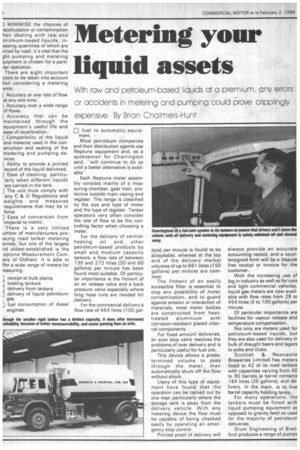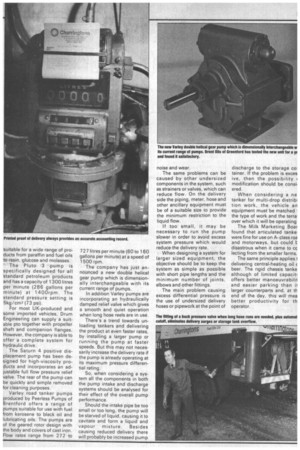Metering your liquid assets
Page 36

Page 37

If you've noticed an error in this article please click here to report it so we can fix it.
With raw and petroleum-basec liquids at a premium, any errors or accidents in metering and oumping could prove cripolingly expensive. By Brian Chalmers-Hunt
) MINIMISE the chances of iscalculation or contamination hen dealing with raw and Dtroleum-based liquids, ineasing quantities of which are ',Tied by road, it's vital that the ght pumping and metering iuipment is chosen for a partiliar operation.
There are eight important ctors to be taken into account hen considering a metering I Accuracy at one rate of flow at any one time.
I Accuracy over a wide range of flows.
I Accuracy that can be maintained through the equipment's useful life and ease of recalibration.
Compatibility of the liquid and material used in the construction and sealing of the metering and pumping devices.
] Ability to provide a printed record of the liquid delivered. 1 Ease of cleaning, particularly when different liquids are carried in the tank.
] The unit must comply with any C & U Regulations and weights and measures requirements that may be in force.
] Ease of conversion from imperial to metric.
There is a very limited umber of manufacturers proucing road tanker metering evices, but one of the largest nd oldest-established is the eptune Measurement Corn any of Oldham. It is able to ffer a wide range of meters for ieasuring: receipt at bulk plants ] loading tankers ] delivery from tankers ] delivery of liquid petroleum gas fuel consumption of diesel engines 0 fuel to automatic equipment.
Most petroleum companies and their distribution agents use Neptune equipment and, as a spokesman for Charrington
said, will continue to do so until a better alternative is available-.
Each Neptune meter assembly consists mainly of a measuring chamber, gear train, protective outside main casing and register. The range is classified by the size and type of meter and the type of register. Tanker operators very often consider the rate of flow to be the controlling factor when choosing a meter.
For the delivery of central heating oil and other petroleum-based products by small and medium capacity tankers, a flow rate of between 136 and 272 litres (30 and 60 gallons) per minute has been found most suitable. Of particular importance is the fitment of an air release valve and a back pressure valve especially where long hose runs are needed for delivery.
For the commercial delivery a flow rate of 454 litres (100 gal Ions) per minute is found to be acceptable, whereas at the top end of the delivery market volumes of up to 681 litres (150 gallons) per minute are common.
The fitment of an easily accessible filter is essential to stop any possibility of meter contamination, and to guard against erosion or interaction of materials, most meter bodies are constructed from heat treated aluminium with corrosion-resistant plated internal components.
For fixed amount deliveries, an auto stop valve resolves the problems of over delivery and is particularly useful for fuel oils.
This device allows a predetermined volume to pass through the meter, then automatically shuts off the flow without shock.
Users of this type of equipment have found that the operation can be carried out by one man particularly where the storage tank is away from the delivery vehicle. With any metering device the flow must be capable of being checked easily by operating an emergency stop control.
Printed proof of delivery will always provide an accurate accounting record, and a countersigned form will be a dispute free receipt or invoice for the customer.
With the increasing use of lpg in industry as well as for cars and light commercial vehicles, liquid gas meters are now available with flow rates from 28 to 454 litres (5 to 100 gallons) per minute.
Of particular importance are facilities for vapour release and temperature compensation.
Not only are meters used for petroleum-based liquids, but they are also used for delivery in bulk of draught beers and lagers to pubs and clubs.
Scottish & Newcastle Breweries Limited has meters fitted to 42 of its road tankers with capacities varying from 4C to 80 barrels (a barrel contains 164 litres (36 gallons), and delivery, in the main, is to five barrel capacity holding tanks.
For many operations, the tankers must be fitted with liquid pumping equipment as opposed to gravity feed as used for the majority of petroleum deliveries.
Drum Engineering of Bradford produces a range of pumps suitable for a wide range of products from paraffin and fuel oils to resin, glucose and molasses.
The Pluto 3 pump is specifically designed for all standard petroleum products and has a capacity of 1300 litres per minute (286 gallons per minute) at 1400rpm. The standard pressure setting is 5kg /cm2 (73 psi).
For most UK-produced and some imported vehicles, Drum Engineering can supply a suitable pto together with propeller shaft and companion flanges. However, the company is able to offer a complete system for hydraulic drive.
The Saturn 4 positive displacement pump has been designed for high-viscosity products and incorporates an adjustable full flow pressure relief valve. The rear of the pump can be quickly and simple removed for cleaning purposes.
Varley road tanker pumps produced by Peerless Pumps of Brentford offers a range of pumps suitable for use with fuel from kerosene to black oil and lubricating oils. The pumps are of the geared rotor design with the body and covers of cast iron. Flow rates range from 272 to 727 litres per minute (60 to 160 gallons per minute) at a speed of 1 500 rpm.
The company has just announced a new double helical gear pump which is dimensionally interchangeable with its current range of pumps.
In addition Varley pumps are incorporating an hydraulically damped relief valve which gives a smooth and quiet operation when long hose reels are in use.
There's a trend towards unloading tankers and delivering the product at even faster rates, by installing a larger pump or running the pump at faster speeds. But this may not necessarily increase the delivery rate if the pump is already operating at its maximum pressure differential rating.
So, when considering a system all the components in both the pump intake and discharge systems should be analysed for their effect of the overall pump performance.
Should the intake pipe be too small or too long, the pump will be starved of liquid, causing it to cavitate and form a liquid and vapour mixture. Besides causing reduced delivery there will probably be increased pump noise and wear.
The same problems can be caused by other undersized components in the system, such as strainers or valves, which can reduce flow. On the delivery side the piping, meter, hose and other ancillary equipment must be of a suitable size to provide the minimum restriction to the 'liquid flow.
If too small, it may be necessary to run the pump slower in order to avoid excess system pressure which would reduce the delivery rate.
When designing a system for larger sized equipment, the objective should be to keep the system as simple as possible with short pipe lengths and the minimum number of joints, elbows and other fittings.
The main problem causing excess differential pressure is the use of undersized delivery hoses or pipework at the point of
discharge to the storage co tamer. If the problem is exces ive, then the possibility modification should be consi, ered.
When considering a ne tanker for multi-drop distribi tion work, the vehicle an equipment must be matched • the type of work and the terra over which it will be operating The Milk Marketing Boar found that articulated tankei were fine for use on Aclass roa and motorways, but could t disastrous when it came to cc lecting from the smaller farms.
The same principle appliesi delivering central-heating oil beer. The rigid chassis tanke although of limited capacit offers better manoeuvrabilii and easier parking than ii larger counterparts and, at th end of the day, this will mea better productivity for th operator.








































































































































